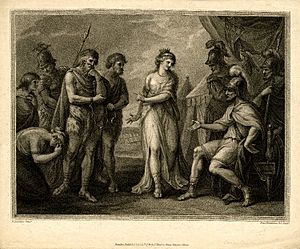Cartimandua facts for kids
Quick facts for kids Cartimandua |
|
|---|---|
| Queen of the Brigantes | |

"Caractacus, King of the Silures, deliver'd up to Ostorius, the Roman General, by Cartismandua, Queen of the Brigantes." – print by F. Bartolozzi, British Museum.
|
|
| Reign | c. AD 43 – c. AD 69 |
| Successor | Venutius |
| Born | c. 1st century AD |
| Died | after c. AD 69 |
| Spouse | Venutius (divorced) Vellocatus |
Cartimandua (reigned around 43 AD to 69 AD) was a powerful queen in the 1st century AD. She ruled the Brigantes, a Celtic tribe living in what is now northern England.
She became queen around the time the Romans began conquering Britain. Her tribe, the Brigantes, became loyal to Rome. The only information we have about her comes from the Roman historian Tacitus. He shows that she was very important in early Roman Britain.
Her name might come from old Celtic words meaning "chase" or "send" and "pony."
Contents
Who Was Queen Cartimandua?
Cartimandua is first mentioned by Tacitus in 51 AD. But she might have been queen even earlier, when the Roman emperor Claudius started the conquest of Britain in 43 AD. She might have been one of the "kings" who gave up without a fight, as Claudius's records suggest.
If not, she might have become queen after a rebellion by some Brigantes was stopped by the Roman general Publius Ostorius Scapula in 48 AD.
How She Became Queen
Tacitus said Cartimandua was of "illustrious birth." This means she was likely born into a royal family and inherited her power. She probably did not become queen by marrying someone important.
She and her husband, Venutius, were described as loyal to Rome. The Romans even protected them with their army.
The Story of Caratacus
In 51 AD, a British leader named Caratacus was defeated by the Romans in Wales. He ran to Cartimandua for safety. However, Cartimandua captured him and handed him over to the Romans in chains.
This was a huge gift to Emperor Claudius, who showed Caratacus off in his victory parade. Cartimandua was rewarded with great wealth for her loyalty.
Challenges to Her Power
Later, Cartimandua divorced Venutius. She chose his armour-bearer, Vellocatus, to be her new partner. This made Venutius very angry.
In 57 AD, Venutius started a war against Cartimandua. He also fought against her Roman protectors. He gathered allies from other tribes. During this time, the Roman governor Aulus Didius Gallus (52–57 AD) sent soldiers to defend Cartimandua.
The fighting was tough until a Roman general named Caesius Nasica arrived with a large Roman army unit called a legion (the IX Hispana). They defeated the rebels. Cartimandua kept her throne because of this quick Roman help.
What Happened to Cartimandua?
Cartimandua was not as lucky in 69 AD. This was a time of trouble for the Romans, known as the Year of the Four Emperors. Venutius used this Roman instability to start another rebellion. He again had help from other tribes.
Cartimandua asked the Romans for troops. But the Romans could only send a smaller group of soldiers called auxiliaries. Cartimandua was taken to safety, but Venutius took control of her kingdom. After this, Cartimandua disappears from history. We don't know what happened to her next.
How Historians See Her
The Roman historian Tacitus wrote about Cartimandua in his books, the Annals and the Histories. He often showed her in a negative way.
He mentioned her loyalty to Rome. But he also described her as "treacherous" for handing over Caratacus, who had sought her protection. He also spoke of her "self-indulgence."
However, Tacitus always called her a "queen" (regina). She is the only female British leader of that time known by this title. Boudica, another famous female British leader, was not described as a queen by Tacitus.
See also
 In Spanish: Cartimandua para niños
In Spanish: Cartimandua para niños

